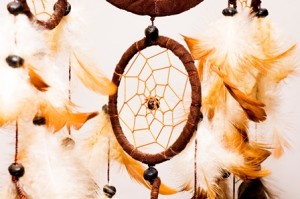 Dreamcatchers (or Spider Web Charms) originate from the Ojibwe (also called Chippewa) Native American tribes whose traditional homeland is near the Great Lakes Region.
Dreamcatchers (or Spider Web Charms) originate from the Ojibwe (also called Chippewa) Native American tribes whose traditional homeland is near the Great Lakes Region.
Ojibwe – White Earth Band
– meaning “net-like, looks like a net”
“Bwaajige Ngwaagan”
Ojibwe – Curve Lake Band
– meaning “dream snare”Dreamcatchers.
In the early 1900s dreamcatchers were made of willow, sinew and nettle-stalk cord died red with bloodroot, typically made in a circular or tear-drop shape.
The Native Americans believed that dreamcatchers were powerful protection against negative energies. Traditionally these were hung above the bed to ensnare nightmares within the webbing, which would dissolve with the morning dew and first light of dawn. Only good dreams could filter through the hole in the middle protecting the sleeper.
Dreamcatchers were made by Ojibwe mothers to give to their children.
The dreamcatcher would be hung above the cradle to keep the babies amused as the wind turned the dreamcatcher round and round and the feathers fluttered in the breeze. From a young age the Ojibwe people are taught awareness and appreciation of the natural elements.
The parts that make up a dreamcatcher have their own special meanings. The round shape of the frame represents the sun; the symbol of the hoop was sacred to the Ojibwe tribes as it represented unity and completeness. The web weaving is to honour the Spider, a sacred creature of the Native American totem, and also to represent the patterns of life of how we weave in and out, supporting and pulling, connecting and linking with people and situations. Beads that are scattered in the web symbolise good dreams, while a single bead may represent the Spider watching over its web. Traditionally dreamcatchers are made with 8 points, like spiders having 8 legs. The feathers used also had their own meanings; owl feathers represented wisdom (typically for women) and eagle feathers represented courage (typically for men).
Adult dreamcatchers are made from woven fibres and normally do not have feathers. Crystals were not traditionally used in dreamcatchers by the Old Ones, although now in the West (due to laws preventing sale of rare bird feather) some like to place a gemstone in the four corners to symbolise the 4 elements or cardinal points.
The willow frame of the dreamcatcher would eventually dry out, weaken and snap. This was also part of the design of dreamcatchers and symbolises the temporary-ness of youth.
~by Tahlia #0450
Websites for further Info
http://www.nativetech.org


